Assess Your Readiness to Implement UCaaS

- Employees no longer work in the office all the time and have adopted a hybrid or remote policy.
- Security is on your mind when it comes to the risks associated with data and voice across the internet.
- You are unaware of the technology used by other departments, such as sales and marketing.
Our Advice
Critical Insight
- The importance of doing your due diligence and building out requirements is paramount to deciding on what UCaaS solution works for you. Even if you decide not to pursue this cloud-based service, at least you have done your homework.
- There are five reasons you should migrate to UCaaS: flexibility & scalability, productivity, enhanced security, business continuity, and cost savings. Challenge your selection with these criteria at your foundation and you cannot go wrong.
Impact and Result
With features such as messaging, collaboration tools, and video conferencing, UCaaS enables users to be more effective regardless of location and device. This can lead to quicker decision making and reduce communication delays.
Assess Your Readiness to Implement UCaaS Research & Tools
Besides the small introduction, subscribers and consulting clients within this management domain have access to:
1. Assess Your Readiness to Implement UCaaS Storyboard – Research that reviews the business drivers to move to a UCaaS solution.
In addition to examining the benefits of UCaaS, this deck covers how to drive toward an RFP and convince the C-suite to champion your UCaaS strategy.
- Assess Your Readiness to Implement UCaaS Storyboard
2. UCaaS Readiness Questionnaire – Three sets of questions to help determine your organization's readiness to move to a UCaaS platform.
This questionnaire is a starting point. Sections include: 1) Current State Questionnaire, 2) IT Infrastructure Readiness Questionnaire, and 3) UCaaS Vendor Questionnaire. These questions can also be added to an RFP for UCaaS vendors you may want to work with.
- UCaaS Readiness Questionnaire
Further reading
Assess Your Readiness to Implement UCaaS
Unified communication as a service (UCaaS) is already here. Find the right solution for your organization, whether it is Teams Phone or another solution.
Analyst Perspective
UCaaS is the solution to the hybrid and remote working world
Hybrid/remote work is a reality and there is little evidence to prove otherwise despite efforts to return employees to the office. A 2023 survey from Zippia says 74% of US companies are planning to or have implemented hybrid work policies. Given the reality of the new ways people work, there’s a genuine need for a UCaaS solution.
The days of on-premises private branch exchange (PBX) and legacy voice over internet protocol (VoIP) solutions are numbered, and organizations are examining alternative solutions to redundant desk phones. The stalwarts of voice solutions, Cisco and Avaya, have seen the writing on the wall for some time: the new norm must be a cloud-based solution that integrates via API with content resource management (CRM), email, chat, and collaboration tools.
Besides remaining agile when accommodating different work locations, it’s advantageous to be able to quickly scale and meet the needs of organizations and their employees. New technology is moving at such a pace that utilizing a UCaaS service is truly beneficial, especially given its AI, analytics, and mobile capabilities. Being held back by an on-premises solution that is capitalized over several years is not a wise option.

John Donovan
Principle Research Director, I&O Practice
Info-Tech Research Group
Insight Summary
Improved integration and communication in a hybrid world
Unified communication as a service (UCaaS) integrates several tools into one platform to provide seamless voice, video, chat, collaboration, sharing and much more. The ability to work from anywhere and the ability to use application programming interfaces (APIs) to integrate content resource management (CRM) and other productivity tools into a unified environment is a key component of employee productivity, whether at the office or remote, or even on mobile devices.
Simplify your maintenance, management, and support
Communication and voice using a cloud provisioner has many benefits and makes life easier for your IT staff. No more ongoing maintenance, upgrades, patching and managing servers or private branch exchanges (PBXs). UCaaS is easy to deploy, and due to its scalability and flexibility, users can easily be added or removed. Now businesses can retire their legacy technical debt of voice hardware and old desk phones that clutter the office.
Oversight on security
The utilization of a software as a service (SaaS) platform in UCaaS form does by design risk data breaches, phishing, and third-party malware. Fortunately, you can safeguard your organization’s security by ensuring the vendor you choose features SOC2 certification, taking care of encryption, firewalls, two-factor authentication and security incident handling, and disaster recovery. The big players in the UCaaS world have these features.
Executive Summary
Your ChallengeSo, your legacy PBX is ready to be replaced. It has no support or maintenance contract, and you face a critical decision. You could face these challenges:
|
Common ObstaclesBusinesses may worry about several obstacles when it’s time to choose a voice and collaboration solution. For example:
|
Info-Tech’s ApproachIt’s critically important to perform due diligence and build out requirements when deciding what UCaaS solution works for you. Even if you decide not to pursue this cloud-based service, at least you will:
In this advisory deck, you will see a set of questions you must ask including whether Teams is suitable for your business. |
Info-Tech Insight
Determine your communication and collaboration needs. Evaluate your current use of voice, video, chat, collaboration, sharing, and mobility whether for the office or remote work. Evaluate your security and regulatory requirements and needs. Determine the integration requirements when evaluating top vendors.
The evolution of unified communication
How we moved from fax machines and desk phones to an integrated set of tools on one platform in the cloud

Business drivers for moving to UCaaS
What organizations look to gain or save by moving to UCaaS solutions
Flexibility and scalability
Ability to add/remove users and services as appropriate for changing business needs, allowing for quick adaptation to changing markets.
Productivity
Offering features like messaging, collaboration tools, and video conferencing enables users to be more effective regardless of location and device. May lead to quicker decision making and reduced communication delays.
Cost savings
Eliminating the need for on-premises hardware and software, reducing maintenance and support costs. Predictable monthly billing.
Business continuity
Reducing risks of disruption or disaster. Allowing users to work from anywhere when the physical office is unavailable. Additional features can include disaster recovery and backup services.
Enhanced security
UCaaS providers usually offer advanced security and compliance features including encryption, firewall, intrusion detection, and certifications like HIPAA and SOC 2.
KPIs to demonstrate success
What key metrics should businesses measure to demonstrate a successful UCaaS project?
What improvements are needed?
What can be optimized?
| KPI | Measurement |
| User adoption rate |
|
| Call quality and reliability |
|
| Cost savings |
|
| Improved productivity |
|
| Customer satisfaction |
|
| Scalability |
|
What are the surveys telling us?
Different organizations adopt UCaaS solutions for different reasons
95%
Collaboration: No Jitter’s study on team collaboration found that 95% of survey respondents think collaborative communication apps are a necessary component of a successful communications strategy.
Source: No Jitter, 2018.
95%
Security: When deploying remote communication solutions, 95% of businesses say they want to use VPN connections to keep data private.
Source: Mitel, 2018.
31%
Flexibility: While there are numerous advantages to cloud-based communications, 31% of companies intend to use UCaaS to eliminate technical debt from legacy systems and processes.
Source: Freshworks, 2019.
UCaaS adoption
While many organizations are widely adopting UCaaS, they still have data security concerns
UCaaS deployments are growing
UCaaS is growing at a rate that shows the market for UC is moving toward cloud-based voice and collaboration solutions at a rate of 29% year over year.
Source: Synergy Research Group, 2017.
Security is still a big concern
While it’s increasingly popular to adopt cloud-based unified communication solutions, 70% of those companies are still concerned about their data security.
Source: Masergy, 2022.
Concerns around security range from encrypting conversations to controlling who has access to what data in the organization’s network to how video is managed on emerging video communications platforms.
Info-Tech Insight
Ensure you maintain a robust security posture with your data regardless of where it is being stored. Security breaches can happen at any location.
UCaaS vs. on-premises UC
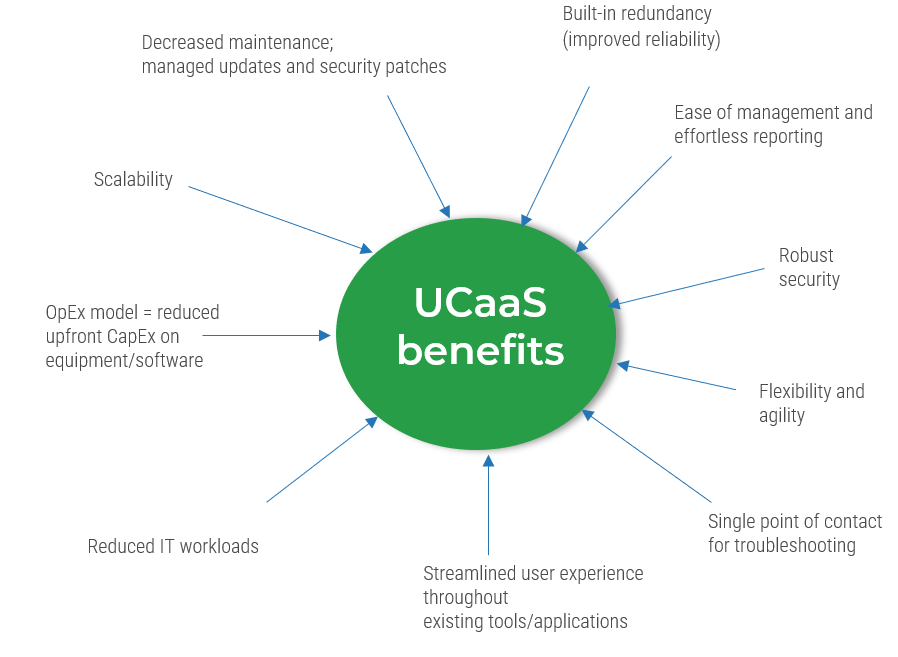
Main benefits of UCaaS
- Rapid deployment: Cloud hosting provides the ability to deploy quickly.
- Ease of management: It’s no longer necessary for companies to manage communications across multiple platforms and devices.
- Better connection: The communication flow across teams and with customers is faster and easier with phone, messaging, audio and video conferencing available in one place.
- Scalability: Since UCaaS is an on-demand service, companies can scale their communication needs to what’s immediately required at an affordable price.
Info-Tech Insight
There are five reasons you should migrate to UCaaS. They are advanced technology, easily scalable, cost efficiencies, highly available, and security. There are always outliers, but these five criteria are a reliable foundation when assessing a vendor/product.
UCaaS architecture
The 6 primary elements of UCaaS
Unified communications as a service (UCaaS) is a cloud-based subscription service primarily for communication tools such as voice, video, messaging, collaboration, content sharing, and other cloud services over the internet. It uses VoIP to process calls.
The popularity of UCaaS is increasing with the recent trend of users working remotely full or part-time and requiring collaboration tools for their work.
- The main benefit to businesses is the ability to remove on-premises hardware and reduce technical debt.
- Additionally, it removes the need for expensive up-front capital costs and reduces communications costs.
- From a productivity perspective, delivering these services under one platform/service increases effective collaboration and allows instant communication regardless of device or location.
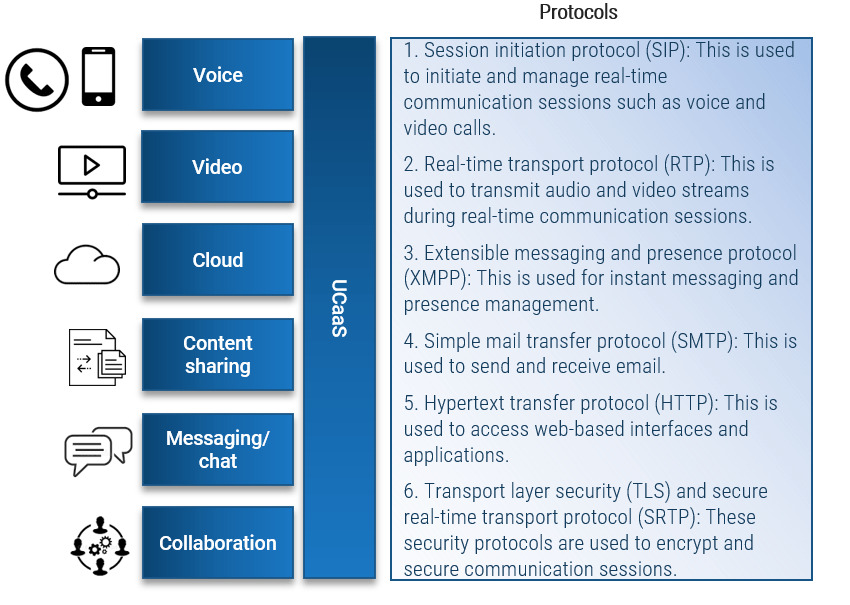
Features available to UCaaS/UC
Must-haves vs. nice-to-haves
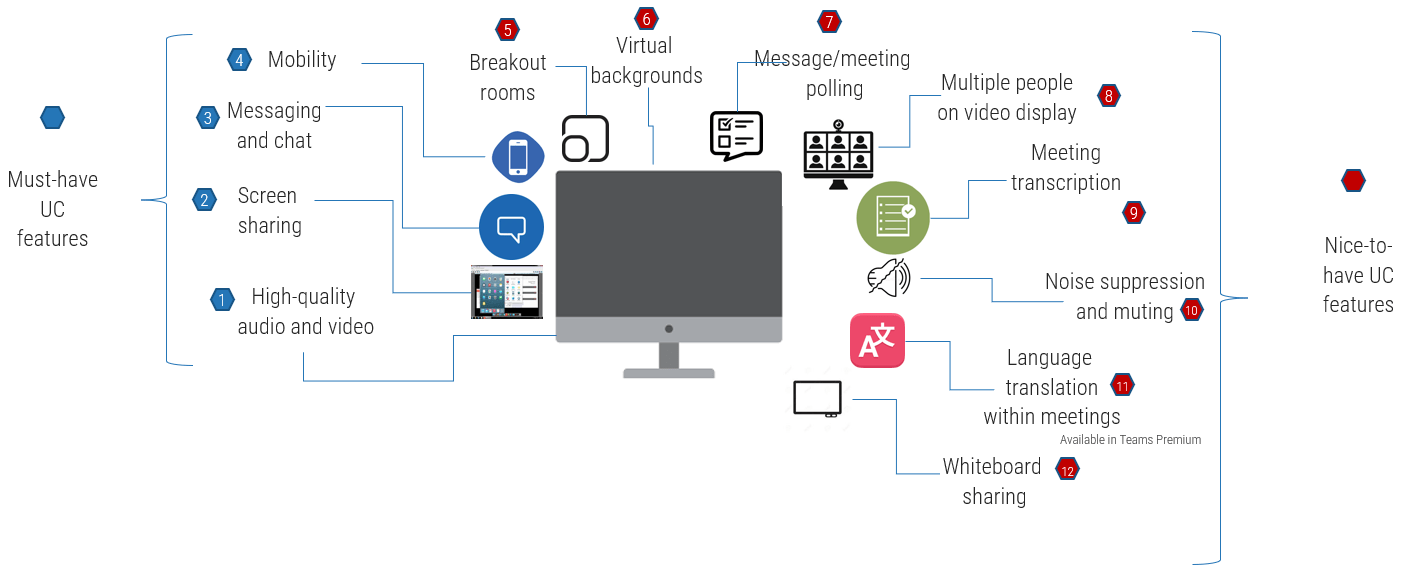
Info-Tech Insight
Decide what matters most to the organization when choosing the UC platform and applications. Divide criteria into must-have vs. nice-to-have categories.
Security and UCaaS
- Maintain company integrity
- Enhance data security
- Regulatory compliance
- Reduce risk of fraud
- Protect data for multiple devices
What are the concerns? What is at risk?
- DDoS attacks: Enterprise transactions are paralyzed by flooding of data across the network preventing access
- Phishing: Users are tricked into clicking a URL and sharing an organization’s sensitive data
- Ransomware: Malicious attack preventing the business from accessing data and demanding a ransom for access
- Third-party malware: Software infected with a virus, trojan horse, worms, spyware, or even ransomware with malicious intent
Security solutions in UCaaS
End-to-end encryption is critical
SRTP
- Secure real-time protocol is a cryptographic protocol used to secure voice & video calls over IP networks
- SRTP provides encryption, message authentication, and integrity protection for voice and data packets. Using advanced encryption standard (AES) reduces chance of DDoS attacks
TLS
- Transport layer security (TLS) is a cryptographic protocol that secures data in transit over the internet, protecting from interception and tampering
VPNs and firewalls
- Virtual private networks (VPNs) are used to secure and encrypt connections between remote devices and the network. UCaaS providers can use VPN to secure access from remote locations
- Firewalls are your primary line of defense against unauthorized traffic entering or leaving the network
SIP
- Session initiated protocol (SIP) over TLS is used to initiate and terminate video and voice calls over the internet. UCaaS providers often use SIP over TLS to encrypt and secure SIP messages
SSH
- Secure shell (SSH) is a cryptographic network protocol used to secure remote access and communications over the network. SSH is often used by UCaaS providers to secure remote management and configuration of systems
Info-Tech Insight
Encryption is a must for securing data and voice packets across the internet. These packets can be vulnerable to eavesdropping techniques and local area network (LAN) breaches. This risk must be mitigated from end to end.
UCaaS
Seven vendors competing with Microsoft’s integrated suite of collaboration tools
Zoom

Best for large meetings and webinars
Key features:
- Virtual meetings up to 300 users, up to 1,000 with enterprise version
- Team chat
- Digital whiteboard
- Phone
RingCentral

Best for project management collaboration tools
Key features:
- Video conferencing up to 200 users
- Chat
- Voice calls
- Video polls and captioning
- Digital whiteboard
Nextiva
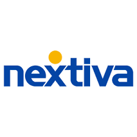
Best for CRM support, best-in-class functionality and features
Key features:
- Single dashboard
- Chat
- Cospace collaboration tool
- Templates
- Voice and call pop
GoTo Connect

Best for integration with other business apps
Key features:
- Video conferencing up to 250 participants
- Meeting transcripts
- Dial plan
Dialpad

Best for small companies under 15 users
Key features:
- Video meetings up to 15 participants
- AI transcripts with call summary
- Call controls share screen, switch between devices
- Channel conversations with calendar app
WebEx
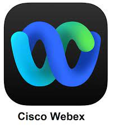
Only vendor offering real-time translation & closed captioning
Key features:
- Video meetings up to 200 participants
- Calling features with noise removal, call recording, and transcripts
- Live polling and Q&A
Google Workspace

Best for whole team collaboration for docs and slides
Key features:
- Google meet video
- Collaboration on docs, sheets, and slides
- Google chat and spaces
- Calendars with sync updates with Gmail and auto-reminders
Avaya and Cisco
The major players in the VoIP on-premises PBX world have moved to a cloud experience to compete with Microsoft and other UCaaS players
Avaya offers the OneCloud UC platform. It is one of the last UC vendors to offer on-premises solutions. In a market which is moving to the cloud at a serious pace, Avaya retains a 14% share. It made a strategic partnership with RingCentral in 2019 and in February 2021 they formed a joint venture which is now called Avaya Cloud Office, a UCaaS solution that integrates Avaya’s communication and collaboration solution with the RingCentral cloud platform.
With around 33% of the UC market, Cisco also has a selection of UC products and services for on-premises deployment and the cloud, including WebEx Calling, Jabber, Unity Connections for voice messaging, and Single Number Reach for extensive telephony features.
Both vendors support on-premises and cloud-based solutions for UC.
Services provided by Avaya and Cisco in the UCaaS space

Avaya Cloud Office
- Voice calling: Cloud-based phone system over the internet with call forwarding, call transfer, voice mail, and more
- Video conferencing: Virtual meetings for real-time collaboration, screen sharing, virtual backgrounds, video layout, meeting recording, whiteboarding and annotation, and virtual waiting room
- Messaging: A feature that allows users to send and receive instant messages and SMS text messaging on the same platform
- Collaboration: Work together on documents and projects in real time. File sharing and task management
- Contact center: Manage customer interactions across voice, email, chat, and social media
- Mobile app: Allows users to access communication and collaboration features on smartphones and tablets
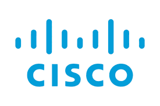
Cisco WebEx
- Voice calling: Cisco WebEx calling provides cloud-based phone system over the internet including call forwarding, transfer, and voice mail
- Video conferencing: Features include virtual meeting and real-time collaboration, screen sharing, and virtual backgrounds and layouts, highly scalable to large audiences
- Messaging: Features include chat and SMS
- Collaboration: Allows users to work together on docs and projects in real time, including file sharing and task management
- Contact center: Multiple contact center solutions offered for small, medium, and large enterprises
- Mobile app: Software clients for Jabber on cellphones
- Artificial intelligence: Business insights, automatic transcripts, notes, and highlights to capture the meeting
Service desk and contact center cloud options
INDUSTRY: All industries
SOURCE: Software reviews
What vendors offer and what they don’t
RingCentral integrates with some popular contact centers such as Five 9, Talkdesk and Sharpen. They also have a built-in contact center solution that can be integrated with their messaging and video conferencing tools.
GoToConnect integrates with several leading customer service providers including Zendesk and Salesforce Service Cloud They also offer a built-in contact center solution with advanced call routing and management features.
WebEx integrates with a variety of contact center and customer service platforms including Five9, Genesys, and ServiceNow.
Dialpad integrates with contact center platforms such as Talkdesk and ServiceNow as well as CRM tools such as Salesforce and HubSpot.
Google Workspace integrates with third-party contact center platforms through their Google Cloud Contact Center AI offering.
SoftwareReviews
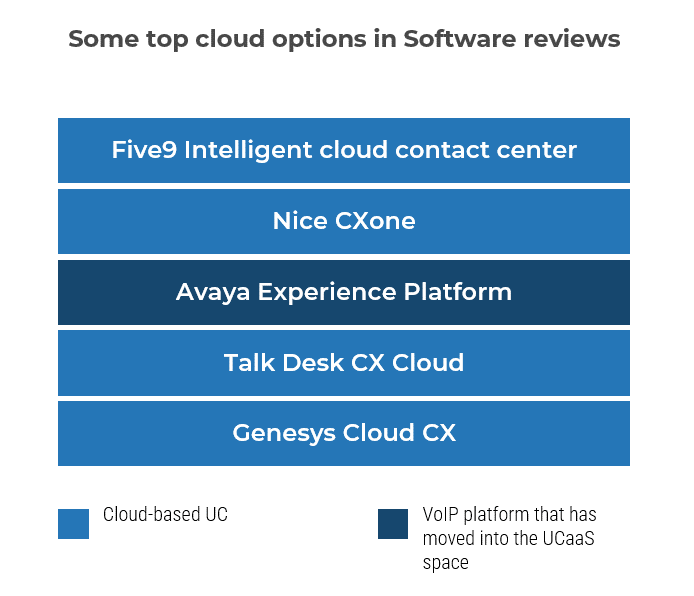
UCaaS comparison table
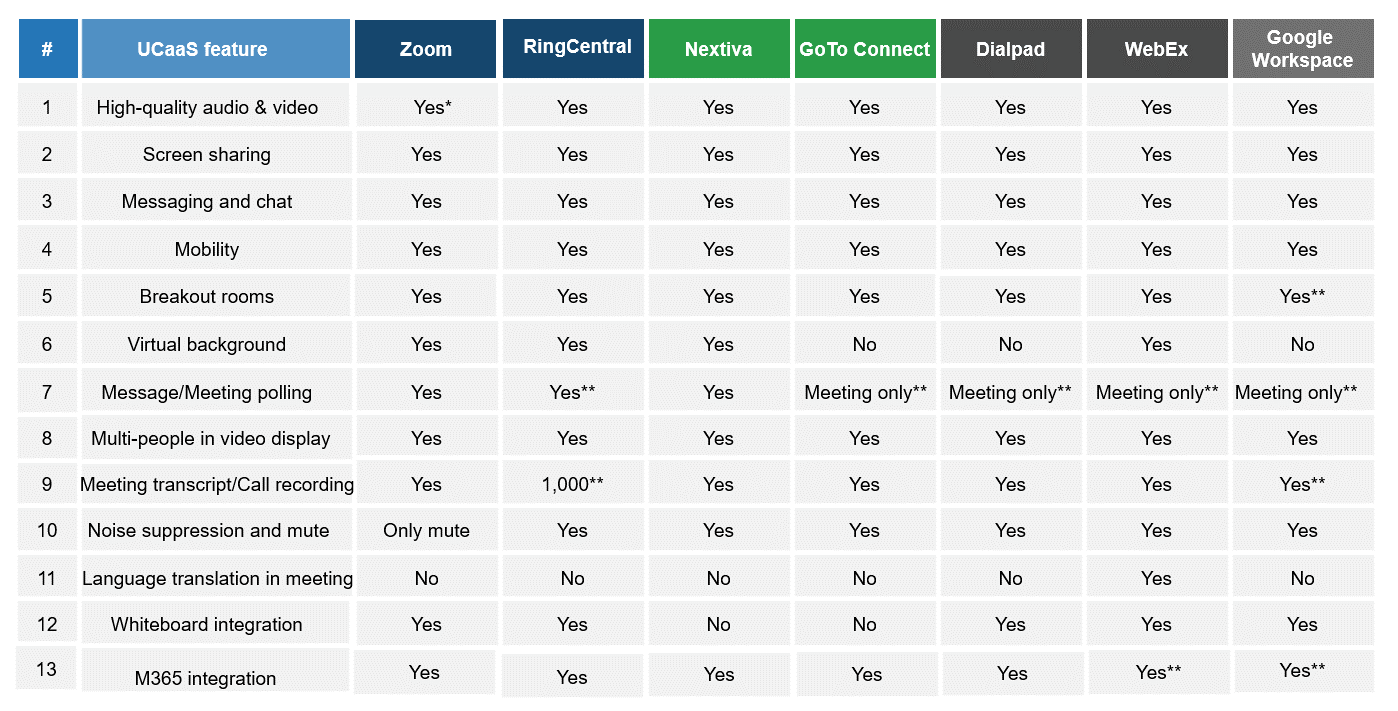
* Some reported issues around sound and voice quality may be due to network
**Limited to certain plans
Differences between UCaaS and CPaaS
UCaaS |
CPaaS |
|
|
Defined |
Unified communication as a service – a cloud-based platform providing a suite of tools like voice, video messaging, file sharing & contact center. |
Communication platform as a service – a cloud-based platform allowing developers to use APIs to integrate real-time communications into their own applications. |
|
Functionality |
Designed for end users accessing a suite of tools for communication and collaboration through a unified platform. |
Designed for developers to create and integrate comms features into their own applications. |
|
Use cases |
Replace aging on-premises PBX systems with consolidated voice and collaboration services. |
Embedded communications capabilities into existing applications through SDKs, Java, and .NET libraries. |
|
Cost |
Often has a higher cost depending on services provided which can be quite comprehensive. |
Can be more cost effective than UCaaS if the business only requires a few communication features Integrated into their apps. |
|
Customization |
Offers less customization as it provides a predefined suite of tools that are rarely customized. |
Highly flexible and customizable so developers can build and integrate to fit unique use cases. |
|
Vendors |
Zoom, MS Teams, Cisco WebEx, RingCentral 8x8, GoTo Meeting, Slack, Avaya & many more. |
Twilio, Vonage, Pivo, MessageBird, Nexmo, SignalWire, CloudTalk, Avaya OneCloud, Telnyx, Voximplant, and others. |
Microsoft Teams Phone
UCaaS for Microsoft 365
Consider your approach to the telephony question. Microsoft incorporates telephony functionality with their broader collaboration suite. Other providers do the opposite.
Microsoft’s voice solution
These options allow you to plan for an all-cloud solution, connect to your own carrier, or use a combination of all cloud with a third-party carrier. Caveat: Calling plans must be available in your country or region.
How do you connect with the public switched telephone network (PSTN)?
Microsoft has three options for connecting the phone system to the PSTN:
Calling Plan
- Uses Microsoft's phone system and adds a domestic and international calling plan, which enables worldwide calling but depends on your chosen license
- Since PSTN Calling Plan operates out of Microsoft 365, you are not required to deploy/maintain on-premises hardware
- Customers can connect a supported session border controller (SBC) via direct routing if it’s necessary to operate with third-party PBX analog devices or other voice solutions supported by the SBC
- You can assign your phone numbers directly in the Teams Admin Center
This plan will work for you if:
- There is a calling plan available in your region
- You don’t need to maintain your PSTN carrier
- You want to use Microsoft's managed PSTN
- No SBC is necessary in your organization
- Teams provides all the features your business needs
Operator Connect
- Leverage existing contracts or find a new operator from a selection of participating operators
- Operator-managed infrastructure, your operator manages PSTN calling services and SBC
- Faster, easier deployment, quickly connect to your operator and assign phone numbers directly from Teams Admin Center
- Enhanced support and reliability, operators provide technical support and shared service level agreements
- Customers can connect a supported SBC via Direct Routing for interoperability with third-party PBXs, analog devices, and other third-party voice solution equipment supported by SBC
This plan will work for you if:
- There is no calling plan available in your region
- Your preferred carrier participates in the Microsoft operator connect plan
- You are looking to get a new operator that enables calling in Teams
Direct Routing
- Connect your own supported SBC to Microsoft Phone System directly without needing additional on-premises software
- Use virtually any voice solution carrier with Microsoft Phone System
- Can be configured and managed by customers or by your carrier or partner (ask if your carrier or partner provides this option)
- Configure interoperability between your voice solution equipment (e.g., a third-party PBX and analog devices) and Microsoft Phone System
- Assign phone numbers directly from Teams Admin Center
This plan will work for you if:
- You want to use Teams with Phone System
- You need to retain your current PSTN carrier
- You want to mix routing – some calls are going via Calling Plans, some via your carrier
- You need to interoperate with third-party PBXs and/or equipment such as overhead pagers, analog devices
- Teams has all the features that your organization requires
For more information, go to Microsoft Teams call flows.
Teams phone architecture
Microsoft offers three options that can be deployed based on several factors and questions you must answer.
Microsoft Teams phone considerations when connecting to a PSTN
- Do you want to move on-premises users to the cloud?
- Is Microsoft's PSTN Calling Plan available in your region?
- Is your preferred operator a participant in the Microsoft Operator Connect Program?
- Do you want or need to keep your current voice carrier (e.g., does an existing contract require you to do so)?
- Do you have an existing on-premises legacy PBX that you want or need to keep?
- Does your current legacy PBX offer unique business-critical features?
- Do all/any of your users require features not currently offered in Phone System?
1. Phone System with Calling Plan
All in the cloud for Teams users
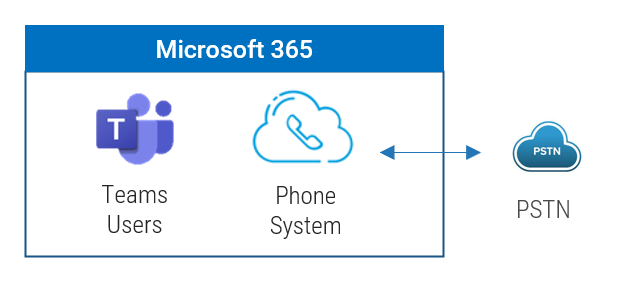
Infrastructure requirements:
| Requires uninterrupted connection with Microsoft 365 | Yes |
| Available worldwide* | No |
| Requires deploying and maintaining a supported session border controller (SBC) | No |
| Requires contract with third-party carrier | No |
*List of countries where calling plans are available: aka.ms/callingplans
2. Phone System with own carrier via operator connect
Phone system in the cloud; connectivity to on-premises voice network for Teams users
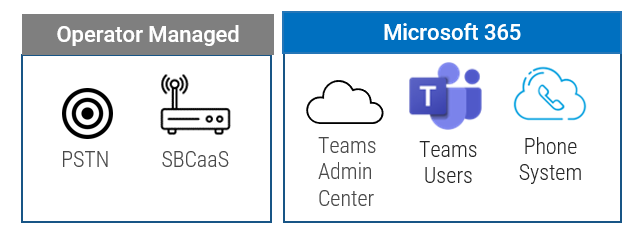
Infrastructure requirements:
| Requires uninterrupted connection with Microsoft 365 | Yes |
| Available worldwide* | No |
| Requires deploying and maintaining a supported session border controller (SBC) | No |
| Requires contract with third-party carrier | Yes |
*List of countries where Operator Connect is available: aka.ms/operatorconnect
3. Phone System with own carrier via Direct Routing
Phone system in the cloud; connectivity to on-premises voice network for Teams users

Infrastructure requirements:
| Requires uninterrupted connection with Microsoft 365 | Yes |
| Available worldwide | Yes |
| Requires deploying and maintaining a supported session border controller (SBC) | Yes |
| Requires contract with third-party carrier* | Yes |
*Unless deployed as an option to provide connection to third-party PBX, analog devices, or other voice equipment for users who are on Phone System with Calling Plans
A Metrigy study found that 70% of organizations adopting MS Teams are using direct routing to connect to the PSTN
Note: Complex organizations with varying needs can adopt all three options simultaneously.
Avoid overpurchasing Microsoft telephony
Microsoft telephony products on a page
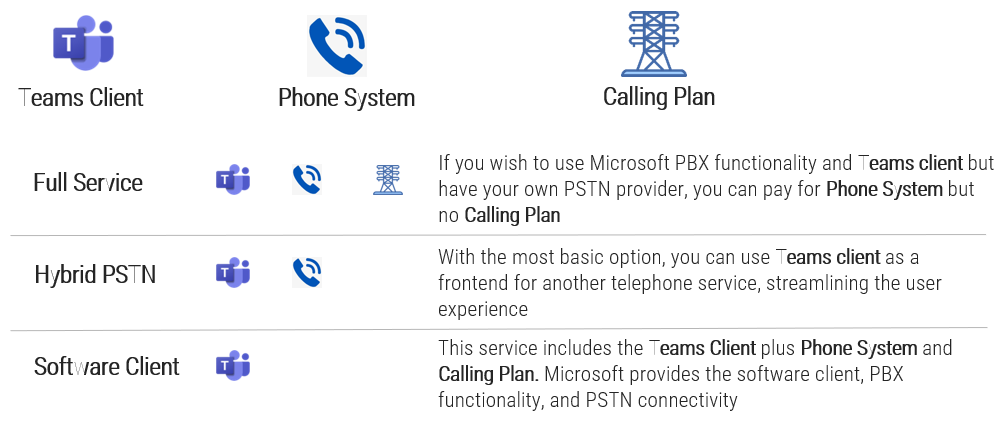
Pros:
- The complete package: sole-sourcing your environment for simpler management
- Users familiar with Microsoft will only have one place to go for telephony
- You can bring your own provider and manage your own routing, giving you more choice
- This can keep costs down as you do not have to pay for calling plan services
- You can choose your own third-party solution while still taking advantage of the integrations that make Microsoft so attractive as a vendor
Cons:
- The most expensive option of the three
- Less control and limited features compared to other pure-play telephony vendors
- This service requires expertise in managing telephony infrastructure
- Avoiding the cloud may introduce technical debt in the long term
- You will have to manage integrations and deal with limited feature functionality (e.g. you may be able to receive inbound calls but not make outbound calls)
Why does it matter?
Phone System is Microsoft’s answer to the premises-based private branch exchange (PBX) functionality that has traditionally required a large capital expenditure. The cloud-based Phone System, offered with Microsoft’s highest tier of Microsoft/Office 365 licensing, allows Skype/Teams customers access to the following features (among others):
- PSTN telephony (inbound and outbound)
- Auto attendants (a menu system for callers to navigate your company directory)
- Call forwarding, voice mail, and transferring
- Caller ID
- Shared lines
- Common area phones
Phone System, especially the Teams version, is a fully-featured telephony solution that integrates natively with a popular productivity solution. Phone System is worth exploring because many organizations already have Teams licenses.
Key insights
- Don’t pay twice for the same service (unless you must). If you already have M/O365 E5 customer, Teams telephony can be a great way to save money and streamline your environment.
- Consider your approach to the telephony question. Microsoft incorporates telephony functionality into a broader collaboration suite. Other providers do the opposite. This reflects their relative strengths.
- Teams is a platform. You can use it as a front end for other telephone services. This might make sense if you have a preferred cloud PBX provider.
Sources
“Plan your Teams voice solution,” Microsoft, 2022.
“Microsoft Calling Plans for Teams,” Microsoft, 2023.
“Plan Direct Routing,” Microsoft, 2023.
“Cisco vs. Microsoft Cloud Calling—Discussing the Options,” UC Today, 2022.
“Microsoft Teams Phone Systems: 5 Deployment Options in 2020,” AeroCom, 2020.
Contact Center and Teams integration
Three Teams integration options
If you want to use a certified and direct routing solution for Teams Phone, use the Connect model.
If you want to use Azure bots and the Microsoft Graph Communication APIs that enable solution providers to create the Teams app, use the Extend model.
If you want to use the SDK that enables solution providers to embed native Teams experiences in their App, use the Power model (under development).
The Connect model features |
The Extend model features |
The Power model features (TBD) |
|
Office 365 authN for agents to connect to their MS tenant from their integrated CCaaS client |
Team graph APIs and Cloud Communication APIs for integration with Teams |
Goal: One app, one screen contact center experience |
|
Use Teams to see when agents are available |
Teams-based app for agent experience Chat and collaboration experience integrated with the Teams Client |
Goal: Adapt using software development kits (SDKs) |
|
Transfers and groups call support for Teams |
Teams as the primary calling endpoint for the agent |
Goal: One dashboard experience |
|
Teams Graph APIs and Cloud communication APIs for integration with Teams |
Teams' client calling for the all the call controls. Preserve performance & quality of Teams client experience |
|
|
Multi-tenant SIP trunking to support several customers on solution provider’s SBC |
Agent experience apps for both Teams web and mobile client |
|
|
Solution providers to use Microsoft certified session border controller (SBC) |
Analytics workflow management role-based experience for agents in the CaaS app in Teams |
Teams phone network assessment
Useful tools for Microsoft network testing and Microsoft Teams site assessment
Plan network basics
- Does your network infrastructure have enough capacity? Consider switch ports, wireless access points, and other coverage.
- If you use VLANs and DHCP, are your scopes sized accordingly?
- Evaluate and test network paths from where devices are deployed to Microsoft 365.
- Open the required firewall ports and URLs for Microsoft 365 as per guidance.
- Review and test E911 requirements and configuration for location accuracy and compliance.
- Avoid using a proxy server and optimize media paths for reliability and quality.
What internet speed do I need for Teams calls?
- Microsoft Teams uses about 1.2 Mbps for HD video calling (720p), 1.5 Mbps for 1080p, 500 kbps for standard quality video (360p). Group video requires about 1 Mbps, HD group video uses about 2 Mbps.
Key physical considerations
- Power: Do you have enough electrical outlets? If the device needs an external power source, how close can you position it to an outlet?
- Device placement: Where will your device be located? Review desk stands, wall mounts, and other accessories from the original equipment manufacturer (OEM).
- Security: Does your device need to be locked in certain spaces?
- Accessibility: Does the device meet the accessibility requirements of its primary user? Consider where it's placed, wire length, and handset or headset usability.
Prepare your organization's network for Microsoft Teams
- Network/Bandwidth requirements: You can probably put together something from these network requirements from Microsoft: https://learn.microsoft.com/en-us/microsoftteams/prepare-network
Plan your Teams voice solution
Check your internet connection for Teams Phone System
- https://learn.microsoft.com/en-us/microsoftteams/business-voice/get-ready-internet
- Microsoft 365 network connectivity test (office.com)
- https://www.microsoft.com/en-us/download/confirmation.aspx?id=103017
Teams Phone Mobile
UCaaS Activity
Questions that must be addressed by your business and the vendor. Site surveys and questionnaires for your assessment
Activity: Questionnaire
Input: Evaluate your current state, Network readiness
Output: Decisions on readiness, Gaps in infrastructure readiness, Develop a project plan
Materials: UCaaS Readiness Questionnaire
Participants: Infrastructure Manager, Project Manager, Network Engineer, Voice Engineer
As a group, read through the questions on Tabs 1 and 2 of the UCaaS Readiness Questionnaire workbook. The answers to the questions will determine if you have gaps to fill when determining your readiness to move forward on a UCaaS solution.
You may produce additional questions during the session that pertain to your specific business and situation. Please add them to the questionnaire as needed.
Record your answers to determine next steps and readiness.
When assessing potential vendors, use Tab 3 to determine suitability for your organization and requirements. This section may be left to a later date when building a request for proposal (RFP).
Call #1: Review client advisory deck and next steps.
Call #2: Assess readiness from answers to the Tab 1 questions.
Download the UCaaS Readiness Questionnaire here
Critical Path – Teams with Phone System Deployment
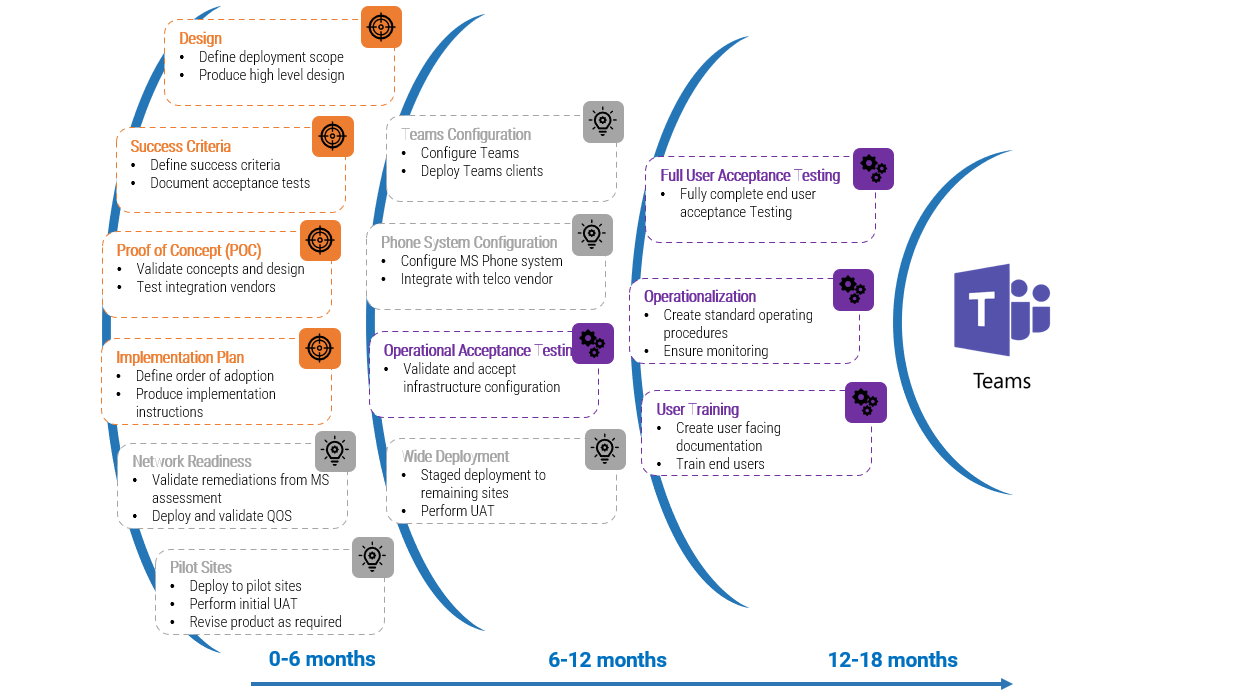
Example Ltd.’s Communications Guide
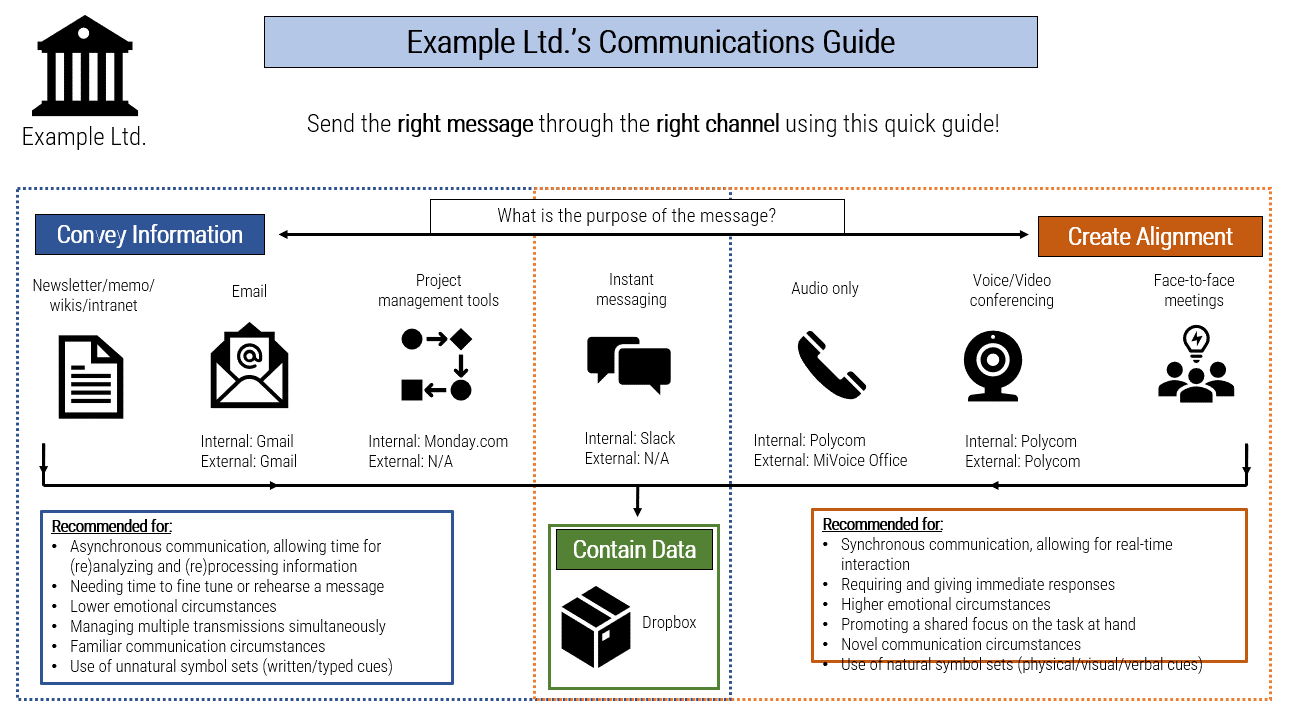
[Insert Organization Name]’s Communications Guide
![A diagram that shows [Insert Organization Name]’s Communications Guide](/images/ITMGF/infra-and-operations/end-user-computing/voice-video-management/assess-your-readiness-to-implement-ucaas/030-communications-guide-template.png)
Related Info-Tech Research
|
|
Modernize Communications and Collaboration InfrastructureOrganizations are losing productivity from managing the limitations of yesterday’s technology. The business is changing and the current communications solution no longer adequately connects end users. A new communications and collaboration infrastructure is due to replace or update the legacy infrastructure in place today. |
|
|
Establish a Communication and Collaboration System StrategyCommunication and collaboration portfolios are overburdened with redundant and overlapping services. Between Office 365, Slack, Jabber, and WebEx, IT is supporting a collection of redundant apps. This redundancy takes a toll on IT, and on the user. |
|
|
Implement a Transformative IVR Experience That Empowers Your CustomersLearn the strategies that will allow you to develop an effective interactive voice response (IVR) framework that supports self-service and improves the customer experience. |
Bibliography
“8 Security Considerations for UCaaS.” Tech Guidance, Feb. 2022. Accessed March 2023.
“2022 UCaaS & CCaaS market trends snapshot.” Masergy, 2022. Web.
“All-in-one cloud communications.” Avaya, 2023. Accessed April 2023. Web.
Carter, Rebekah. “UC Case Study in Focus: Microsoft Teams and GroupM.” UC Today, 9 May 2022. Accessed Feb. 2023.
“Cisco Unified Communications Manager Cloud (Cisco UCM Cloud) Data Sheet.” Cisco, 15 Sept. 2021. Accessed Jan. 2023.
“Cloud Adoption as Viewed by European Companies: Assessing the Impact on Public, Hybrid and Private Cloud Communications.” Mitel, 2018. Web.
De Guzman, Marianne. “Unified Communications Security: The Importance of UCaaS Encryption.” Fit Small Business, 13 Dec. 2022. Accessed March 2023.
“Evolution of Unified Communications.” TrueConf, n.d. Accessed March 2023. Web.
Froehlich, Andrew. “Choose between Microsoft Teams vs. Zoom for conference needs.” TechTarget, 7 May 2021. Accessed March 2023.
Gerwig, Kate. “UCaaS explained: Guide to unified communications as a service.” TechTarget, 29 March 2022. Accessed Jan. 2023.
Irei, Alissa. “Emerging UCaaS trends include workflow integrations and AI.” TechTarget, 21 Feb 2020. Accessed Feb. 2023.
Kuch, Mike. “What Is Unified Communications as a Service (UCaaS)?” Avaya, 27 Dec. 2022. Accessed Jan. 2023.
Lazar, Irwin. “UC vendors extend mobile telephony capabilities.” TechTarget, 10 Feb. 2023. Accessed Mar 2023.
McCain, Abby. "30 Essential Hybrid Work Statistics [2023]: The Future of Work." Zippia, 20 Feb. 2023. Accessed Mar 2023.
“Meet the modern CIO: What CEOs expect from their IT leaders.” Freshworks, 2019. Web.
“A New Era of Workplace Communications: Will You Lead or Be Left Behind.” No Jitter, 2018. Web.
Plumley, Mike, et al. “Microsoft Teams IT architecture and voice solutions posters.’” Microsoft Teams, Microsoft, 14 Feb. 2023. Accessed March 2023.
Rowe, Carolyn, et al. “Plan your Teams voice solution” Microsoft Learn, Microsoft, 1 Oct. 2022.
Rowe, Carolyn, et al. “Microsoft Calling Plans for Teams.” Microsoft Learn, Microsoft, 23 May 2023.
Rowe, Carolyn, et al. “Plan Direct Routing.” Microsoft Learn, Microsoft, 20 Feb. 2023.
Scott, Rob. “Cisco vs. Microsoft Cloud Calling—Discussing the Options,” UC Today, 21 April 2022.
Smith, Mike. “Microsoft Teams Phone Systems: 5 Deployment Options in 2020.” YouTube, uploaded by AeroCom Inc, 23 Oct. 2020.
“UCaaS - Getting Started With Unified Communications As A Service.” Cloudscape, 10 Nov. 2022. Accessed March 2023.
“UCaaS Market Accelerating 29% per year; RingCentral, 8x8, Mitel, BroadSoft and Vonage Lead.” Synergy Research Group, 16 Oct. 2017. Web.
“UCaaS Statistics – The Future of Remote Work.” UC Today, 21 April 2022. Accessed Feb. 2023.
“Workplace Collaboration: 2021-22.” Metrigy, 27 Jan. 2021. Web.
Buying Options
Assess Your Readiness to Implement UCaaS
IT Risk Management · IT Leadership & Strategy implementation · Operational Management · Service Delivery · Organizational Management · Process Improvements · ITIL, CORM, Agile · Cost Control · Business Process Analysis · Technology Development · Project Implementation · International Coordination · In & Outsourcing · Customer Care · Multilingual: Dutch, English, French, German, Japanese · Entrepreneur
Tymans Group is a brand by Gert Taeymans BV
Gert Taeymans bv
Europe: Koning Albertstraat 136, 2070 Burcht, Belgium — VAT No: BE0685.974.694 — phone: +32 (0) 468.142.754
USA: 4023 KENNETT PIKE, SUITE 751, GREENVILLE, DE 19807 — Phone: 1-917-473-8669
Copyright 2017-2022 Gert Taeymans BV


